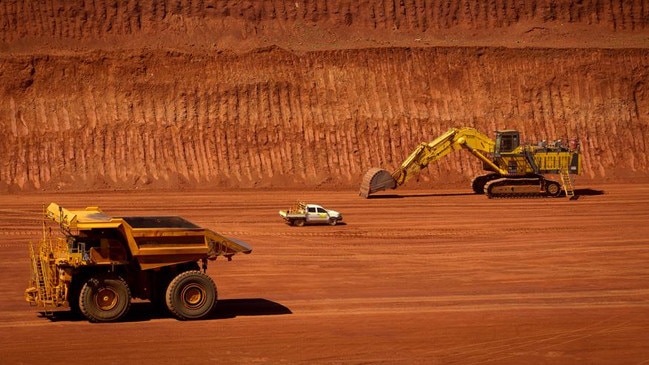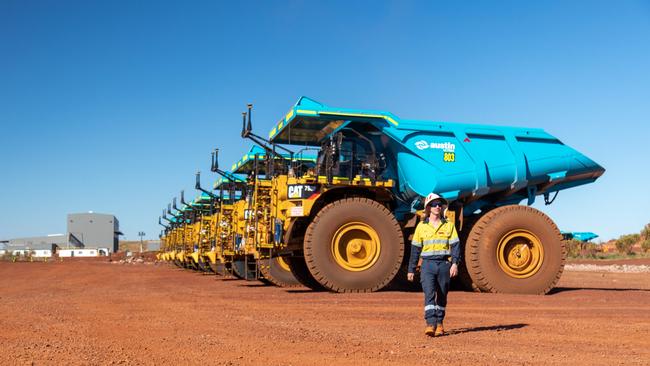Rio Tinto says cost inflation at Pilbara iron ore division still rising
Rio has kept its 2023 iron ore guidance in line with initial expectations for 2022, but says costs are still rising at its flagship division.

Rio Tinto expects next year’s average Pilbara production costs to top $US20 a tonne for the first time since 2013 as inflation bites, while saying it may see only a small increase in export rates.
The mining giant held its annual investor day in London overnight on Wednesday, with Rio chief executive Jakob Stausholm saying the company needed to continue to improve its performance amid “volatile and challenging” markets.
Rio issued the same iron ore shipment guidance as it did for 2022, at 320 to 335 million tonnes, with minimal growth forecast for alumina and aluminium compared to current expectations, and about 50,000 tonnes of additional mined copper output for the year.
But the company again sounded a warning on cost inflation in the Pilbara, saying it expected to ship iron ore at an average $US21 to $US22.50 a tonne for the year, well above the $US19.50 to $US21 a tonne it last said it expected to average over 2022.
Like the rest of the mining industry Rio has been hit by soaring diesel costs, and flagged 5 to 10 per cent lifts in the costs of labour amid mining skills shortages, and similar rises in the costs of other raw materials.
Average copper costs will likely lift to $US1.60 to $US1.80 a pound, up from current guidance of $US1,50 to $US1.70 – and well above initial 2022 expectations of $US1.30 to $US1.50.
In the modern era, Rio’s average Pilbara production costs dropped below the $US20 a tonne mark for the first time in the second half of 2014, with the company averaging costs of $US19.50 for the full year.
That year Rio shipped 302.6 million tonnes of iron ore.
Rio’s initial 2022 production guidance was for 320 to 335 million tonnes of iron ore from its Pilbara mines. Plus 54 to 57 million tonnes of bauxite, 8 to 8.4 million tonnes of alumina, 3.1 to 3.2 million tonnes of aluminium, 500,00 to 575,000 tonnes of mined copper, and 230,000 to 290,000 tonnes of refined copper.
Its last production guidance, delivered in its September quarter results, suggested its iron ore exports would fall towards the bottom end of the guidance range, with refined copper output downgraded to 190,000 to 220,000 tonnes.
For 2023 Rio said it expects 550,000 to 600,000 tonnes of mined copper, and 180,000 to 210,000 tonnes of refined copper.
Rio also updated its Pilbara decarbonisation plans on Wednesday, committing another $US600m – part of the $US7.5bn it plans to spend by the end of the decade – on building two 100MW solar power facilities as well as 200MWh of on-grid battery storage in the Pilbara by 2026.
Speaking to investors in London, Rio chief executive Jakob Stausholm said the company still faced “volatile and challenging” markets, and remained highly aware it had not lived up to its own standards over the last few years.
“For the last three years, we have failed to hit production guidance. Relationships with Traditional Owners were broken and too transactional. We were not investing in the long-term health of our most valuable business,” he said.
But Mr Stausholm said the company’s focus on its operations was now beginning to create “real momentum” for the future.
“Over the past 18 months, we have signed critical new agreements with the Yindjibarndi, Yinhawangka and PKKP peoples, demonstrating a significant rebuild of those relationships,” he said.
“We are on track to deliver one of our best second half production results. We have commissioned Gudai-Darri, our first greenfield mine in almost a decade. We future-proofed the business for decades to come by unlocking high-grade tonnes from Rhodes Ridge. And we are moving ahead with plans to install 1GW of renewable energy.”
Rio took a major step towards future-proofing its Pilbara operations in October, after the company finally promoted the long-stalled development of its Rhodes Ridge deposit towards the top of its pipeline.
Rhodes Ridge contains 5.8 billion tonnes at 62.3 per cent iron – and a high grade zone of around 500 million tonnes grading close to 64 per cent iron, making it a worthy competitor for development dollars compared to Rio’s other global options, including Simandou in Guinea, where development work has already begun.
While Rio initially plans only a 40 million tonne mine at Rhodes Ridge, hoping to be in production by the end of the decade, the company believes the size of the extended deposit could eventually sustain multiple mining hubs and make up the backbone of its Pilbara exports.
Rio’s initial 2022 production guidance was for 320 to 335 million tonnes of iron ore from its Pilbara mines. Plus 54 to 57 million tonnes of bauxite, 8 to 8.4 million tonnes of alumina, 3.1 to 3.2 million tonnes of aluminium, 500,00 to 575,000 tonnes of mined copper, and 230,000 to 290,000 tonnes of refined copper.
Its last production guidance, delivered in its September quarter results, suggested its iron ore exports would fall towards the bottom end of the guidance range, with refined copper output downgraded to 190,000 to 220,000 tonnes. Rio also downgraded alumina and aluminium guidance during the year.
In 2023 it expects to ship 320 to 335 million tonnes of iron ore from its Pilbara mines, 54 to 57 million tonnes of bauxite, 7.7 to 8 million tonnes of alumina, 3.1 to 3.3 million tonnes of aluminium, 550,00 to 600,000 tonnes of mined copper, and 180,000 to 210,000 tonnes of refined copper.
Rio shares closed up $1.79 to $109.62 on Wednesday.
More Coverage




